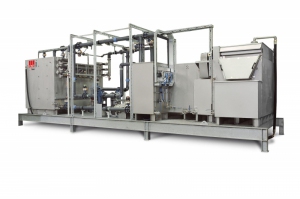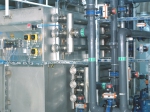Ultrafiltration
The central feature of these water treatment units is the ultrafiltration process using a molecular filter. These molecular filters employ the cross-flow method to separate any foreign bodies held in suspension by their molecular weights and sizes. Once a difference in pressure between the two sides has been generated, the membranes act like a sieve. Any particles smaller than the pores in the membranes are allowed to pass through as permeate, while all larger molecules or particles are retained as residues. This kind of separation technology is easy to handle and requires very little energy.
Sump pumps transfer the precleaned suspension from the cleaning and paint-removal booths to the corresponding containers in the water recovery unit. The easily adjustable flow rate for the permeate enables the unit to be optimised to match the inline process. Double-action gates, controlled by a software program, enable the numerous cleaning cycles to be run in either automatic mode or in manual mode.
Ecological aspects: water may only be used as a cleaning tool if it is disposed of afterwards in an environmentally responsible manner.
Economic aspects: the conditions under which waste water may be disposed of are prescribed by legislation*.
The costs of conventional waste water disposal come to around € 2 to € 5 per m3 of water (as in 2007). Using the RST water recovery unit, the costs of waste-water disposal and consumption of clean water can be reduced by up to 90%, because 90% of the cleaned water is recycled by the WAA.




